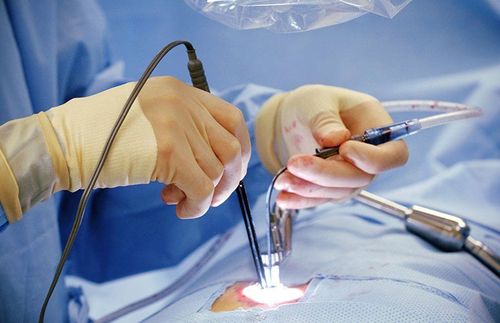This is an automatically translated article.
The article is professionally consulted by Master, Doctor Pham Van Hung - Department of Medical Examination & Internal Medicine - Vinmec Danang International General Hospital.
Some congenital heart defects are easily treated without surgery. The choice of congenital heart surgery method or not depends on the type and severity of the patient's heart defect.
1. Types of congenital heart defects
Most congenital heart defects change the normal blood flow through the heart resulting in a part of the heart not developing normally before birth. Modern medicine has now recognized many types of congenital heart defects from simple to complex.Some simple congenital heart defects: The heart has a hole in the septum between the two chambers of the heart, allowing blood from the right and left heart to mix. Or a narrow heart valve that blocks blood flow to the lungs or other parts of the body, for example, an atrial septal defect, a ventricular septal defect. More complex defects, which include a combination of simple defects, problems with the placement of blood vessels going to and from the heart, and more serious problems with the heart's growth. Examples: Pulmonary valve stenosis, large VSD, overriding aorta, right ventricular hypertrophy.
2. What causes congenital heart defects?
Currently, doctors have not found the exact cause of congenital heart defects, possibly because:Genetics can play a role in some heart defects. For example, parents with a congenital heart defect are more likely to have a child with the condition than others. Children with genetic disorders such as Down syndrome are more likely to have congenital heart defects. Smoking during pregnancy has also been linked to some congenital heart defects.

3. Congenital heart treatment
Not every case requires surgery for a congenital heart defect, and treatment depends on the type and severity of the heart defect. Other factors include the person's age, height, weight, and overall health. If the congenital heart does not affect the life, development and quality of life of the child, it is only necessary to intervene through the catheter without surgery.3.1 Cardiovascular interventions Catheter interventions are much easier than surgery because doctors only use medical instruments through veins or arteries to enter the heart chambers, blood vessels large for the treatment of heart disease, especially the treatment of congenital heart disease. Doctors do not have to open the chest and operate directly on the heart to repair the defect. This means easier and quicker recovery, less blood loss, less infection, and no scarring.
The application of cardiovascular interventions has grown tremendously over the past 20 years and has become the method of first choice for doctors to correct many simple heart defects, such as an atrial septal defect (atrial septal defect). ASD) and pulmonary valve stenosis.
Some other congenital diseases can also be treated through the catheter quite effectively such as: percutaneous stenosis pulmonary valve angioplasty, percutaneous stenosis aortic angioplasty, coarctation of the aorta, Close some abnormal fistulas of coronary arteries or other arteries by catheter without surgery.
For obstructive hypertrophic cardiomyopathy, ventricular septal resection was often required in the past with many complicated complications. It is now possible to thin the interventricular septum by selectively injecting alcohol into the coronary artery feeding the interventricular septum through a catheter. This method is less invasive and gives good results.
Although there are many advantages over thoracic surgery, cardiovascular intervention still has some disadvantages such as: too complicated damage or large lesions without instruments of appropriate size, patients must switch to open surgery. Besides, when using this method, although the complication rate is low, there may be risks of the instrument falling, the patient having bleeding complications, having to switch to open heart surgery.
3.2 Surgery When it is not possible to choose to repair congenital heart defects by cardiovascular intervention techniques, to ensure the patient's health, the doctor will choose open congenital heart surgery. Patients with complex congenital heart defects need one surgery that can correct all defects or multiple surgeries to gradually correct the problem.
Open heart surgery can be done to:
Close the holes in the heart with stitches or with a patch. Repair or replace heart valves. Enlarged arteries or widens heart valves. Repair complex defects, such as problems with the placement of blood vessels near the heart. In more extreme cases, babies born with too many defects that cannot be repaired through surgery may need a heart transplant. In this surgery, the heart of a sick child is replaced with a healthy heart from a deceased child that has been donated by the child's family.

Vinmec International General Hospital currently has all the professional conditions and technical means to perform diagnostic and treatment methods for congenital heart defects. At Vinmec, there is a team of highly qualified and experienced cardiologists; modern medical equipment, up to international standards; professional service quality, helping to improve the efficiency of diagnosis and give the right and timely treatment measures.
Master, Doctor Pham Van Hung has 30 years of experience in examination and treatment of internal diseases, especially in Cardiology: coronary arteries, heart failure, heart valves, arrhythmias. ..Master, Dr. Hung used to hold the position of Deputy Head of Internal Cardiology Department and Head of Interventional Cardiology Unit at Da Nang General Hospital and is currently working at Department of Medical Examination and Internal Medicine, Internal Cardiology, and Cardiology. Interventional circuit at Vinmec Da Nang International General Hospital.
Please dial HOTLINE for more information or register for an appointment HERE. Download MyVinmec app to make appointments faster and to manage your bookings easily.
Reference source: surgery.ucsf.edu













